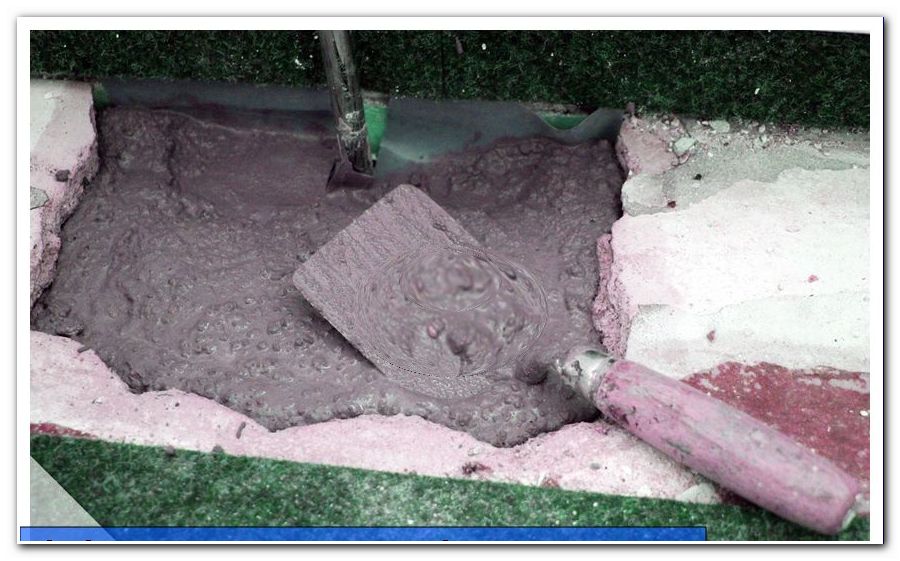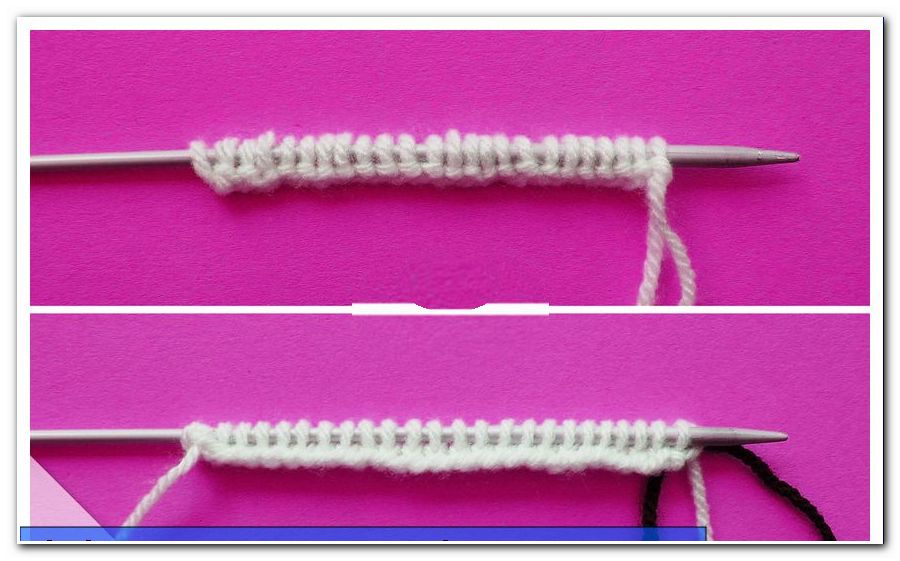Cut and glue Styrodur correctly

- General information
- To cut
- glue
- Connection work: painting
Styrodur is an excellent insulation material, but is also used in model making and in many other areas. The question quickly arises as to how the building material can best be processed and which adhesive is suitable. Read how to glue Styrodur boards properly and ensure sustainable installation.
Mostly the building material is offered in plates. These must first of all be tailored to the right size. Already here it is important to select the correct procedure, so that there is no damage to the Styrodur boards. Then you have to pick the right glue and attach the plates. Thus, you realize with the help of the building material numerous projects, such as the roof insulation or the aquarium construction. To give the plates an exciting look, you can paint them afterwards. Again, we have included a small guide with the main points in this guide. Even problems like fixed nicotine can be solved.
General information
Styrodur is the trade name of XPS, an extruded foam. It is suitable among other things for insulation and insulation. Whether in the area of the floors, the walls or the base - the application possibilities are manifold in the construction. In all cases, it is important to connect the panels firmly to the ground. This ensures the perfect function and convinces the design. The panels form the basis for finishing work in the attic and for improving the energy balance.
Difference Styrodur and Styrofoam
The starting material is the same in both - but it is once "inflated" (expanded) and once "pressed out" as viscous measures.
EPS (Styrofoam) is EXPANDED ("puffed") polystyrene
XPS (Styrodur) is EXTRUDED ("extruded") polystyrene.
EPS (Styrofoam) consists of individual beads and is cheaper
XPS (Styrodur) is insensitive to water and significantly more pressure-resistant


Be careful when working with Styrodur
Properly used, the material develops a first class insulating effect. However, if it is processed incorrectly, then beads may form or the plates may disintegrate. Another problem is the static charge of the plates. You must therefore use special tools for cutting. Another danger concerns the health aspects. When gluing, make sure to choose a glue that is as harmless as possible and then thoroughly aerate it.
To cut
Select the knife
There are special tools for cutting. For example, specialist retailers offer insulation knives and insulation saws. They have a special finish, allowing them to glide effortlessly through the Styrodur without creating breakouts or fraying. The Japanese saw also does a good job cutting Styrodur. However, these tools make it difficult to create tight curves and intricate cuts. These finishes require the use of electric cutters (see below).
Cutter knives are also suitable for rough processing. However, they sometimes get stuck in the material. Due to the strength of Styrodur a clean and straight cut is possible.

It is sometimes mentioned the good old bread knife, when cutting insulation materials. I can only say that it is rather unsuitable for cutting Styrodur, as it is a very dirty cut. For Styrofoam it is probably better suited.

Electric Styrodur cutter and hot wire device
Especially for larger projects, such as the expansion of an attic, electrical equipment for cutting are the right choice. You have the choice between hot wire devices and a little more handy Styrofoam cutters. Here, a wire or a blade are heated by means of electricity. The heat ensures that the cutting tool can easily slide through the Styrodur. Even curves and sections can thus be realized.
The straight cut
Especially when working with larger tools, it is important that you mark the cut edges before starting work. Use a felt-tip pen and a ruler for this. If the plates are then painted over, then you can use a very thick pen, which makes the job easier. Note that when cutting dust is formed, which deposits on the plate and thus can easily hide thin lines.

Cutting the Styrodur plate
Electric cutting tool must first reach the correct operating temperature. Therefore, first of all carry out a test cut on a styrofoam test to see if the optimum temperature has been reached. For hot wire devices, be careful not to overpressure. Otherwise, the wire may break.
For cutting with the craft knife it is good to fix the Styrodur plate with screw clamps and to use a simple plywood board or a board as a knife guide.
Cutting with cutter 1 of 4



glue
Choose the right glue
To glue the Styrodur you need special Styrodur glue. This should be solvent-free. Solvent-based adhesives would lead to decomposition of the material.

Styrodur boards can however be fixed with different types of glue. One option is silicone. Make sure, however, that you choose the most odorless option possible. However, if the plates are used in the aquarium or similar areas, then you can also use the respective special adhesive, as in this case aquarium silicone. Quick-tile adhesives and assembly adhesives are also suitable for this job.
Here you can find information about different types of assembly adhesives, as well as their prices and application: assembly adhesive
If there are still gaps between the individual plates after gluing, fill them with PU foam.

Tip: Be sure to apply the adhesive over a large area. A punctual application has the disadvantage that the plates can deform. In addition, gaps form by which the insulating effect is reduced.
Manual:
- Clean the surface
To keep the plates well on the surface to be bonded, you must first clean the surface. Especially in the construction phase it quickly comes to dust deposits that interfere with the liability. - Fill in imperfections
The panels should be glued to a level floor. Therefore, you should remove bumps. For this you fill larger holes and thus provide for a straight surface. - Choose the right glue
Specialist shops sell special adhesives for Styrodur boards. Often this must be touched first. Always follow the manufacturer's instructions to ensure perfect adhesion. - Glue the plates together
If you want to cover a large area, then the installation should be offset. - The drying
Allow the Styrodur plates to dry sufficiently.

Attach panels to the ceiling
You can also attach the panels to the ceiling for excellent insulation.
- Sweep the blanket with a broom. For a perfect grip, it is important that you remove dust completely.
- Edit cracks in the ceiling. Using repair putty, you can remove cracks and bumps in the ceiling.
- Stir the adhesive or the mortar. Mix the selected adhesive or mortar in a bucket.
- Cut the plates. If you cover a large area, then you have to bring one of the plates to the correct size for the first row.
- Apply the glue. Apply the glue to the back of the plates. Attach it over a large area.
- Glue the plates to the ground. When attaching, make sure that the panels are offset. This will prevent the formation of thermal bridges.
- Sand off bumps.
- Fill in the joints with PU foam.
Connection work: painting
You can paint the panels with wall paint or ceiling paint. This gives both old and new plates an exciting look.
Tip: Please note that the plates may need to be cleaned regularly. In this case, it should be an easy-to-clean color. Latex paints have proven themselves in this area. An advantage of emulsion paint, however, is that it is breathable. As a result, this color variant is best suited for the indoor climate. Avoid solvent-based inks. They would attack the material and cause damage.
Step 1: After gluing, clean the plates thoroughly. Dirt as well as dust prevent the success of the work.
Step 2: If you have formed joints or cracks in the material, then you must repair them with an elastic grout. Fill in the appropriate places and pay attention to a level surface. Bumps are more noticeable after painting than before.
Step 3: Then do the first coat of paint. Here, the color is absorbed by the plates in large part, so that a second coat is necessary.
Tip: The color should not be diluted, as it spreads better, but also drips and is increasingly absorbed.
Problems can arise when painting, if it is old plates and was previously smoked in the room. In this case nicotine has accumulated in the material. This can lead to the dissolution of the nicotine when brushing and this mixes with the color. The new coat has a yellowish effect.
Tip: Use a water-soluble insulation paint that rarely causes these problems. More problematic in this case is emulsion paint.
Step 4: Swipe at least a second time to make it opaque.

Tips for quick readers:
- clean the ground
- select suitable adhesive
- Silicone or assembly adhesive are suitable
- Cut the plates with a craft knife
- Fill in unevenness
- Transfer laid offset
- lay completely
- Fill joints with PU foam
- Allow the glue to dry well before the next steps
- Plates can be painted over
- cover at least twice
- Do not dilute the paint
- Use isolation paint on nicotine deposits




